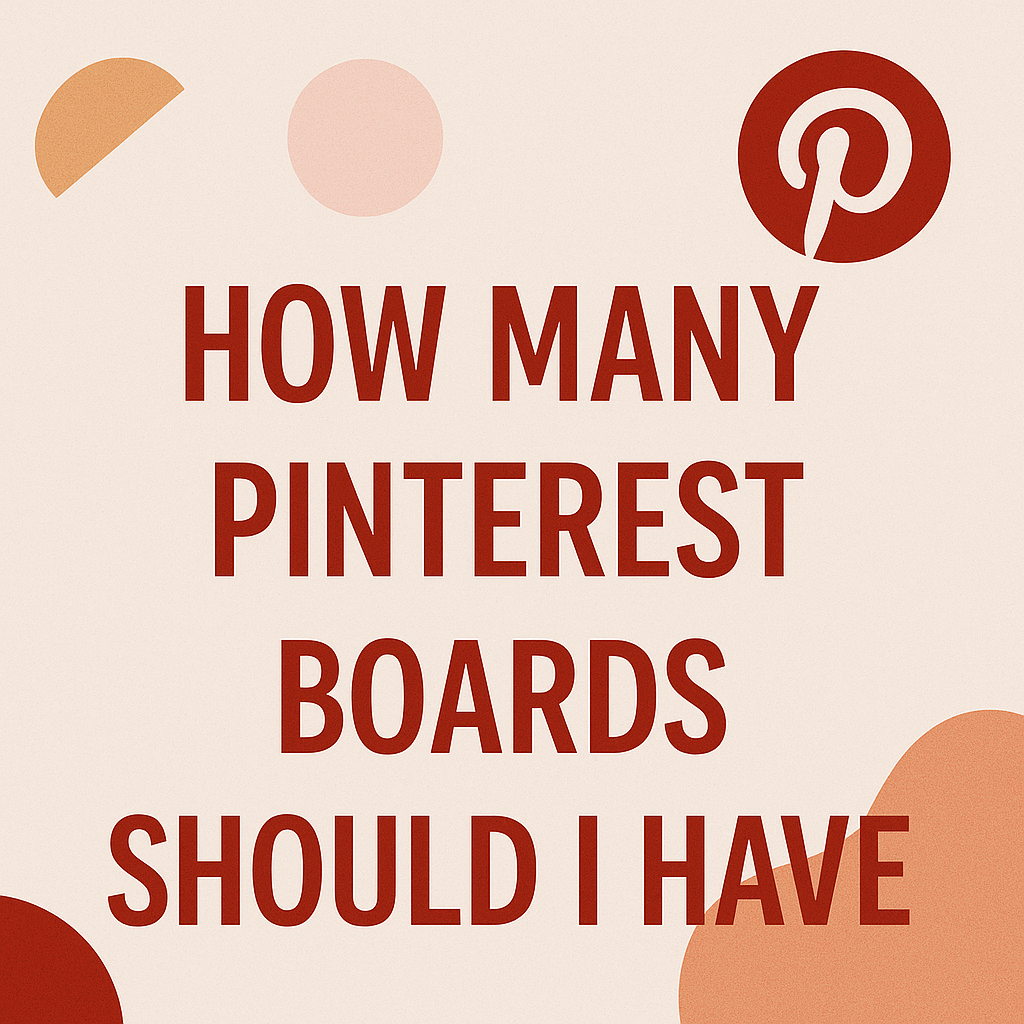Organizing content on Pinterest can feel overwhelming, especially when starting out. A common challenge is determining the right number of boards to create. While there’s no universal answer, understanding your goals and audience makes all the difference.
Think of boards as digital folders that categorize your ideas, products, or inspiration. They help users navigate your profile while signaling to Pinterest’s algorithm what your content is about. More boards don’t always mean better results—quality and relevance matter most.
New users often ask if they’re overcomplicating their approach. The truth? Your ideal board count depends on factors like your niche, content volume, and growth stage. A lifestyle blogger might need more categories than a local boutique, for example.
Strategic organization also impacts how easily others discover your pins. Well-structured boards with clear keywords improve SEO and help Pinterest recommend your content to interested audiences. We’ll explore practical tips to balance creativity with algorithm-friendly practices.
Key Takeaways
- Board quantity should align with your content diversity and business objectives
- Clear categorization improves user experience and search visibility
- Seasoned accounts often benefit from more specialized boards
- Keyword-rich board titles and descriptions boost SEO performance
- Regular audits help maintain relevance as your brand evolves
Understanding Pinterest Boards
Imagine your favorite recipe box, but for digital inspiration. Boards act like labeled containers where you group similar ideas—think of them as themed collections for your pins. This structure helps users browse your content while telling algorithms what topics you focus on. If you’re unsure how to locate your Pinterest links efficiently, this guide on retrieving your Pinterest URL and pin links quickly offers step-by-step instructions.
What Are Pinterest Boards?
These tools let you save and sort pins by theme or purpose. A crochet blogger, for example, might create separate boards for “Winter Hat Patterns” and “Beginner Stitch Guides.” Clear categories make profiles easier to navigate, like chapters in a visual book.
Pinterest Boards and SEO Explained
Search engines prioritize relevance, and so does this platform. Titles like “Quick Dinner Recipes Under 30 Minutes” perform better than vague names like “Food Ideas.” Why? Keywords in board titles and descriptions help Pinterest match your content to user searches.
Let’s say someone looks for “fall crochet scarves.” A board titled exactly that—packed with pins about autumn-themed designs—will rank higher. Regular updates with targeted keywords keep your collections visible as trends shift.
Crafting a Winning Pinterest Strategy
Transforming scattered ideas into cohesive visual stories begins with intentional planning. A clear roadmap helps turn random pins into purposeful collections that drive engagement and growth.
Identifying Your Content and Product Themes
Start by auditing your existing material. What topics does your blog or business consistently cover? List 3-5 core themes—these become your content pillars. For example, a baking account might focus on “Gluten-Free Desserts” or “Quick Bread Recipes.”
Align each board with specific posts or product groups. A fitness coach could create boards like “Home Workout Routines” (linked to tutorial posts) and “Meal Prep Essentials” (featuring kitchen tools). This strategy strengthens SEO by connecting keywords to relevant pins.
- Map themes to seasonal trends and evergreen topics
- Use analytics to identify high-performing content areas
- Limit overlapping categories to avoid confusion
New accounts should prioritize quality over quantity. Begin with 8-10 tightly focused boards, then expand as your content library grows. A travel blogger might start with “Budget Europe Trips” before adding niche boards like “Hidden Cafés in Prague.”
Remember: Each board’s place in your profile should serve a distinct purpose. Regularly review and merge underperforming categories to maintain a streamlined, search-friendly presence.
How Many Pinterest Boards Should I Have: Finding Your Magic Number
Every successful visual strategy has a golden balance. Your board count should feel like a curated museum—not a cluttered attic. This “magic number” evolves with your account’s maturity while keeping people engaged. Brands aiming for stronger product visibility should consider the custom Pinterest strategy included in this package to enhance their online presence.
“Begin with tight focus, then expand like tree branches. Ten core boards let new accounts build authority without dilution.”
Launching Fresh Accounts
New profiles thrive on precision. Start with 8-12 hyper-relevant boards that mirror your top content pillars. A baking coach might create:
- Gluten-Free Desserts (recipes)
- Essential Baking Tools (product guides)
- Holiday Cookie Ideas (seasonal content)
This approach helps Pinterest’s algorithm understand your niche quickly. Marketing analytics show focused accounts gain 40% faster traction than scattered ones. For content creators focused on visual platforms, this article explains how to quickly locate Pinterest URLs to streamline your sharing process.
Growing With Purpose
Established accounts can expand strategically. Add new boards when:
| Trigger | Action | Example |
|---|---|---|
| New product line launches | Create dedicated board | “2024 Spring Collection” |
| Seasonal content spikes | Temporary boards | “Back-to-School Organizing” |
| Audience requests | Address specific needs | “Small Kitchen Baking Hacks” |
Review board performance quarterly. Merge overlapping topics and retire outdated collections. This keeps your profile fresh while maintaining that crucial magic number balance. Learning how outbound clicks influence your Pinterest referral traffic can help refine your overall content strategy.
Optimizing Board Titles and Descriptions
Think of your board titles as digital storefront signs—they need to grab attention while clearly stating what’s inside. Well-crafted names and descriptions act like magnets, pulling both Pinterest’s algorithm and human pinners toward your content.
Keyword Integration That Feels Natural
Start by exploring Pinterest’s search bar. Type phrases related to your niche—like “easy crochet patterns”—and note the auto-suggestions. These reveal trending keywords real users are hunting for. For example, “beginner-friendly crochet scarves” might pop up as a popular query.
Apply these insights when naming boards. Instead of “Scarf Ideas,” try “Quick Crochet Scarves for Beginners – Free Patterns & Tutorials.” This packs search intent into the title without sounding robotic. Descriptions should expand on this, using 1-2 additional keywords naturally:
- “Step-by-step guides for simple scarf designs”
- “Yarn recommendations and seasonal variations”
Boosting Visibility Through Strategic Updates
Social media trends shift faster than knitting needles. Revisit older boards quarterly—update titles with fresh keywords or tweak descriptions to highlight new pins. A “Fall Decor DIY” board could become “2024 Autumn Craft Trends” as seasons change.
Analytics show boards with keyword-rich titles get 3x more saves than generic ones. But remember: clarity trumps cleverness. Users should instantly understand your board’s focus, whether they’re scanning profiles or seeing recommendations.
Avoiding the Pitfall of Board Overload
Visual clutter can sink even the most promising profiles. When boards multiply faster than spring weeds, they confuse both human visitors and algorithms. Excessive categories dilute your account’s focus, making it harder for Pinterest to understand your core themes.
Spotting the Warning Signs
Low engagement often signals redundancy. If a board hasn’t gained saves or clicks in 90 days, it might need pruning. Check if multiple boards cover similar topics—like “Summer Recipes” and “BBQ Ideas”—which could merge into one.
| Red Flag | Solution |
|---|---|
| Fewer than 5 pins/month | Archive or combine with related board |
| Overlapping keywords | Merge boards & update title |
| Outdated seasonal content | Delete after 6 months |
Search algorithms prioritize active, relevant boards. Accounts with 50+ rarely maintained collections see 35% less traffic than those with 20-30 curated ones. Focus on quality pins that align with your website’s core topics.
Regular check-ups keep your profile healthy. Every quarter:
- Review analytics for low-performing boards
- Update descriptions with fresh keywords
- Delete boards unrelated to current goals
Remember: Your blog posts and products should drive board creation—not the other way around. A reader looking for “DIY garden care” expects focused content, not 12 variations of the same idea. Clarity trumps quantity every time.
Planning and Organizing Your Board Content
Mastering visual platforms requires more than creativity—it needs a system. Structured planning turns random posts into cohesive campaigns that resonate with your audience and algorithms alike.
Spreadsheets: Your Secret Weapon
Google Sheets transforms chaotic ideas into actionable strategies. Create columns for:
- Core themes (e.g., “Outdoor Photography Tips”)
- Primary keywords (“nature shots,” “lighting hacks”)
- Content types (tutorials, product roundups)
A food blogger might map “Quick Dinners” to keywords like “30-minute meals” and “budget recipes.” This method prevents overlap and ensures each board serves a unique purpose.
| Manual Planning | Spreadsheet Approach |
|---|---|
| Scattered notes | Centralized data |
| Duplicate topics | Clear category boundaries |
| Guessing game | Metrics-driven decisions |
Curating With Precision
Align pins with what your audience craves. If analytics show interest in “small space gardening,” populate that board with vertical planters and balcony designs. Track engagement monthly using Pinterest’s native analytics or third-party tools like Tailwind.
“Consistent curation builds trust. Pinners return to profiles that deliver focused value.”
Refresh older boards by adding new pins that match trending keywords. A travel account might update “European Backpacking” with current hostel recommendations and visa tips. This keeps content fresh without creating redundant boards.
Systematic organization pays dividends. Accounts using spreadsheets report 50% faster growth in saves and website clicks compared to disorganized peers. Your media strategy becomes a living document—adaptable, measurable, and endlessly relevant.
-
To optimize your Pinterest strategy, it’s crucial to understand how often you should post on Pinterest to maintain consistent engagement.
Conclusion
Building a Pinterest presence that truly resonates requires both art and science. Focus on creating boards that reflect your core content pillars while leaving room for strategic growth. Start with a manageable number—8-12 well-organized categories—then expand as your account matures.
Keyword-rich titles and descriptions remain essential. They act like signposts, guiding both pinners and algorithms to your best work. Regular audits ensure collections stay relevant, merging overlapping themes and retiring outdated ideas.
Your profile’s success hinges on intentional design. Use spreadsheets to map content themes, track performance metrics, and identify gaps. This structured approach prevents clutter while maintaining the “magic number” balance that drives engagement.
Ready to elevate your strategy? Review existing boards this week—streamline redundant categories and refresh descriptions with trending keywords. Small tweaks over time yield significant growth, turning casual browsers into loyal followers.
Remember: Quality boards outlive quantity every time. With careful planning and periodic updates, your account becomes a trusted resource rather than a digital junkyard. Now’s the moment to craft boards that truly work for your goals.

